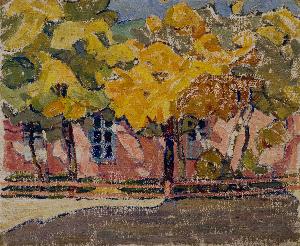Oleksandr Kostiantynovych Bohomazov
Oleksandr Kostiantynovych Bohomazov;Oleksandr Bohomazov
Place: Yampil
Born: 1880
Death: 1930
Biography:
Oleksandr Kostiantynovych Bohomazov was a Ukrainian painter, cubo-futurist, and modern art theoretician, recognized as one of the key figures of the Ukrainian avant-garde scene. Born on March 26, 1880, in Yampil, Ukraine, Bohomazov's artistic journey was marked by innovation and experimentation.
Early Life and Education
Bohomazov's interest in painting began at an early age, but his father disapproved of his style, considering it too raw. Despite this, Bohomazov pursued his passion for art, studying at the Kyiv Academy of Arts from 1902 to 1905. He was taught by prominent artists such as Oleksandr Murashko and Ivan Seleznev. Bohomazov's participation in political demonstrations and strikes led to his expulsion from the academy in 1905.
Artistic Periods
Bohomazov's artistic career can be divided into several periods, each marked by a distinct style. His Finnish Cycle, created in 1911, showcases his impressionist and post-impressionist influences. This period was characterized by his use of vibrant colors and bold brushstrokes, as seen in paintings such as Little Imatra and The Sea Waves. For more information on Bohomazov's Finnish Cycle, visit the Wikioo.org website. Bohomazov's later work was influenced by cubo-futurism and spectralism. His treatise, The Art of Painting and the Elements, written in 1914, analyzed the interaction between object, artist, picture, and spectator, setting the theoretical foundation for modern art. To learn more about Bohomazov's cubo-futurist and spectralist periods, visit the Wikioo.org website.
- Cubo-Futurism (1913-1917): Characterized by Bohomazov's use of geometric shapes and bold colors.
- Spectralism (1920-1930): Marked by Bohomazov's experimentation with light and color.
Legacy
Bohomazov's contributions to Ukrainian avant-garde are immeasurable. His innovative style and theoretical foundations have inspired generations of artists. To explore more of Bohomazov's work, visit the Wikioo.org website or the Wikipedia page. The National Art Museum of Ukraine and the Chernihiv Regional Art Museum also showcase Bohomazov's paintings, including Sawyers and Street on Podil.


